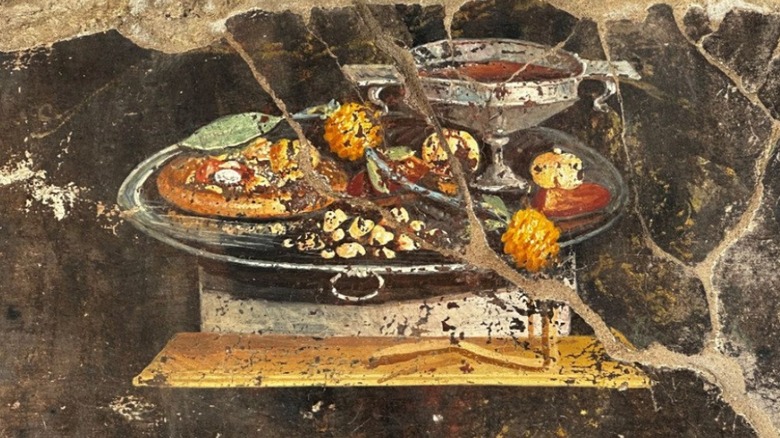Newly Discovered Pompeii Fresco Might Show The Earliest Version Of Pizza
Recently, a fresco (a mural typically painted on plaster) of a dish that looks very similar to a pizza was revealed adorning a house wall at the archeological site of the ancient city of Pompeii. The fresco depicts a silver tray holding a goblet of wine and a sort of flatbread with fruit toppings. The house the fresco was painted on was attached to a bakery, so it seems fair to assume that the fresco does indeed show something akin ton a 2,000-year-old pizza — making it the earliest version of this beloved food. However, there are some facts that throw a wrench into that conclusion.
The main reason some historians and archeologists are claim the fresco cannot be depicting traditional Italian pizza is that the dish doesn't contain tomatoes or mozzarella, two vital components of the dish. When Mount Vesuvius suddenly erupted millennia ago, it coated the nearby city of Pompeii in ash, almost perfectly preserving the city's buildings, roads, and art. While the fresco was painted before the eruption in 79 A.D., mozzarella wouldn't be referenced in any form until the 12th century, and Italy didn't have access to tomatoes until the 16th century.
It is generally accepted that pizza was invented in Naples in the 1700s as a simple, quick meal for the working class. So, if the flatbread in the Pompeian fresco isn't pizza, what is it?
The fresco may have ties to pizza but is more similar to focaccia
Rather than a pizza, the fresco appears to be depicting something closer to an early version of Italian focaccia, which is believed to have been invented long before Mount Vesuvius erupted. Atop the flatbread is pomegranate, spices, some sort of pesto, and what looks like a date. Along with the goblet of wine, the tray also holds what could be walnuts and garland. It's likely that the silver tray full of food is related to "xenia," the ancient Greek tradition of hospitality — this food would be offered to guests as a welcoming gesture.
In a video for The Guardian, the Pompeii Archaeological Park director, Gabriel Zuchtriegel, calls the fruit-laden focaccia a "sacrificial flatbread," and admits that it is reminiscent of pizza, especially given the site's close vicinity to Naples. Zuchtriegel says that while the fresco is not of a pizza, "perhaps it could have been a distant ancestor of this food."
Italy is home to a wealth of fascinating culinary history, like the story of their happy hour. And while it may be false that ancient Italians were snacking on greasy pizza, the truth isn't too far off. Just as we offer pizza to our guests on movie nights, the Pompeians offered their friends fruit and flatbread as they sat around chatting. In that way, the only difference between us is a couple thousand years.

